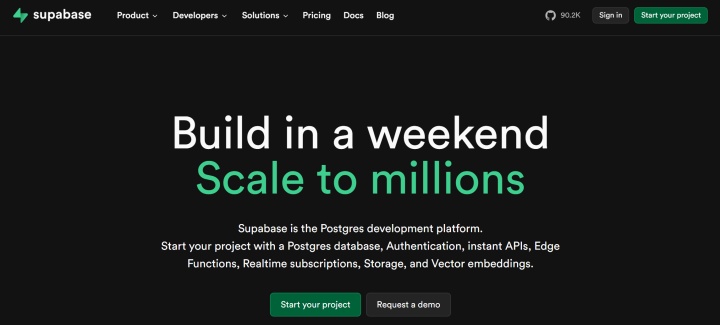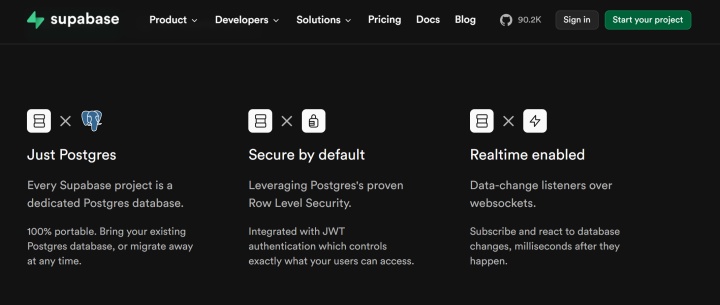Supabase for Beginners: Everything You Should Know
Serverless architecture is currently one of the most sought-after trends in application development. It simplifies feature implementation and accelerates time-to-market for IT products. The rise of such technologies has led to the emergence of a number of serverless development service providers, and we'll discuss one of the most well-known in this article. You'll learn what Supabase is used for, explore the tools and benefits it offers developers, and discover practical recommendations for using this service.
What Is Supabase
Supabase is an open-source BaaS (Backend as a Service) platform that helps optimize the development of backend components for web and mobile apps. It runs on the PostgreSQL relational database and is a popular alternative to Google's Firebase.
Supabase's serverless backend development tools simplify and accelerate the creation of various application features. They allow you to implement data storage, user management, file hosting, and other functionality in just minutes, without the need to launch and configure servers.
The BaaS platform's serverless architecture provides developers with control, flexibility, convenience, and transparency by providing them with all the infrastructure and databases they need to develop and maintain applications.
Built on the PostgreSQL relational database, the service offers a number of advantages that distinguish it from NoSQL counterparts (such as the aforementioned Firebase). We'll discuss the most significant of these in the following sections of this article.
The platform, launched in 2020, was founded by Paul Copplestone and Ant Wilson, the former serving as the company's CEO at the time of writing. Supabase is headquartered in San Francisco, USA, and has over 130 employees based in 35+ countries.

Source: supabase.com
As of 2025, the company has raised over $500 million in funding. Its tools are integrated into popular AI coding services (such as Lovable), and the platform's clients include major corporations and companies (PwC, McDonald's, GitHub, etc.).
Supabase offers the following pricing plans:
- Free (for simple websites and projects, 50,000 active users per month, 500 MB database, Shared CPU, 500 MB RAM, 5 GB outgoing traffic, 1 GB file storage, community support).
- Pro (for production applications with potential for scalability, $25/month, 100,000 active users per month, 8 GB database per project, 250 GB of outgoing traffic, 100 GB of file storage, email support, 7 days of log storage, 7 days of daily backups).
- Team ($599/month, all Pro features + single sign-on (SSO), backup control, industry certifications, 28 days of log retention, 14 days of daily backup retention, priority email support & SLA).
- Enterprise (for high-load applications, price upon request, dedicated account manager, BYO Cloud, premium enterprise support, private Slack channel, customized security questionnaires).
Pricing and package details are subject to change. Please check the official website for the most up-to-date information.
Key Features
In this section of our Supabase guide, you'll learn about the platform's key features and capabilities.
PostgreSQL Database
Each project on the platform represents a dedicated PostgreSQL database. By default, it has access to all of DB tools, which can be expanded through extensions and integrations. The Supabase graphical user interface (GUI) allows you to view data in a convenient tabular format. You can also clone tables, create relationships between them, and run queries in the SQL editor.
The PostgreSQL databases hosted here offer a range of additional features. These include automatic backups, data import from CSV or Excel, project branching, load balancing across multiple databases, viewing and managing databases using a spreadsheet or SQL editor, and more.
Authentication
All projects deployed on the platform are equipped with a native authentication system integrated with other system functions (databases, storage). This allows for access control implementation without third-party software and the selection of optimal storage locations for user data.
Supabase supports various authentication methods: email/password, Google, Facebook, GitHub, Microsoft Azure, GitLab, X, Discord, etc. In addition to authentication, other security tools are also available, such as authorization and user management.
This feature allows application developers to link user records to database records, implementing row-level authentication or access control. Other features include email verification, password reset, and multi-factor authentication.
Storage
Open-source Supabase storage, powered by Amazon S3, provides unlimited scalability, allowing you to store and run large files directly on the platform without the need for third-party solutions.
The storage is tightly integrated with other ecosystem tools, including the PostgreSQL database and authentication. Developers can structure their uploaded files using dedicated container folders.
Other storage features include automatic backups, multiple authentication and authorization methods, real-time updates, and notifications of any file changes or other related events.
Real-Time Updates and Data Synchronization
Supabase real-time database updates and continuous synchronization are provided by PostgreSQL replication and streaming capabilities. This option instantly transmits database changes to client applications for up-to-date data collection.
With it, developers can track user logins and their current status, as well as message delay times. Real-time subscriptions allow you to define the types of data users can subscribe to and receive automatic updates about changes.
The Postgres Changes feature allows you to receive real-time notifications about all CRUD operations performed on the database. And with the Broadcast Realtime feature, you can send mass messages to your application users.
Edge Functions
Supabase edge functions allow developers to embed additional functionality into their applications using JavaScript or TypeScript. They can be used to effectively address a range of tasks, including content management (image optimization, compression, server-side rendering), creating security layers, developing caching strategies, and more.
Using edge tools, you can develop, deploy, monitor, and manage serverless application functions. In addition to management options, version control, a dashboard, and a range of other features are available.
Edge allows you to integrate third-party software into Supabase-based applications, including OpenAI, Stripe, and more. Complete solutions are published in the GitHub repository.
Integrations and APIs
Supabase offers a comprehensive catalog of pre-installed integrations, categorized by topic and easily searchable. These include API services, application templates, authentication services, data platforms, low-code platforms, storage, messaging services, and more.
Furthermore, the platform automatically generates a performant and secure API for applications deployed on it. When creating a table in a PostgreSQL database, it uses the open-source PostgREST tool to analyze the database schema and provide the corresponding RESTful endpoints.
Benefits for Developers

Source: supabase.com
Now we'll explore the most significant advantages of Supabase for beginners and experienced developers:
- Performance. The platform is powered by a high-performance, easily scalable PostgreSQL database and Amazon S3 cloud storage. It is ideal for serving high-load, multi-user applications with large volumes of traffic and files.
- Versatility. Supabase supports various frameworks and programming languages: JavaScript, Python, C#, Kotlin, Flutter, and Swift. Its open-source nature allows for flexible customization and adaptation of its tools to the needs of developers and the objectives of their projects.
- Functionality. The serverless architecture allows you to implement backend functions in applications without having to launch and maintain servers, significantly accelerating development. The graphical interface simplifies and speeds up data management in tables, and the SQL editor allows you to send database queries directly through the dashboard.
- Convenient administration and security. The platform's tools are natively integrated, including the Supabase database, storage, real-time updates, synchronization, edge functions, and more. This streamlines administration processes and ensures reliable data control and security through authentication and user management options.
- Automated APIs. Automatic API generation based on the database schema eliminates the need for developers to create, configure, and manage these interfaces manually.
Getting Started
In this section, we'll cover how to use Supabase to develop and launch a mobile or web app.
1. Create an account on the platform.
- On the official website, click the Start your project button.
- Create a new account using your email address and password, or log in via GitHub.
- After registration, you will be taken to the main Supabase dashboard and can begin working on your project.
2. Create a new project.
- In the dashboard, click on the New Project.
- Enter a project name, specify the desired hosting region, and create a password for the database.
- Once you complete the steps, you will be able to manage your PostgreSQL database.
3. Explore the capabilities of the database.
The Supabase database provides access to a number of useful features, namely:
- Visualization and management of data in tabular format.
- Creating and sending queries to the database via the SQL editor.
- Selecting methods and providers for user authentication.
- Create and manage containers for files in cloud storage.
- Real-time monitoring of logs and events, etc.
4. Integrate the platform with the application.
- Connect the application you are developing to Supabase using the JavaScript client.
- Install the client via the command line.
- Initialize it in your project.
- Use the JavaScript client when interacting with backend functions.
5. Set up authentication and authorization.
- Open the dashboard and select the desired method (email-password, etc.) and provider (Google, Facebook, GitHub, Microsoft Azure, GitLab, X, Discord, etc.) for authentication.
- Set up user authorization via JavaScript client.
- Manage authorized users using supabase.auth methods.
Conclusion
Supabase is a powerful tool for developers that helps them optimize the implementation of backend functionality in applications based on serverless architecture, native PostgreSQL databases, and other features.
Backend development with Supabase significantly simplifies and accelerates the production launch of various mobile and web applications. The platform is easily scalable and therefore ideal for deploying high-load, multi-user IT products.
Routine tasks take a lot of time from employees? Do they burn out, do not have enough working day for the main duties and important things? Do you understand that the only way out of this situation in modern realities is automation? Try Apix-Drive for free and make sure that the online connector in 5 minutes of setting up integration will remove a significant part of the routine from your life and free up time for you and your employees.

